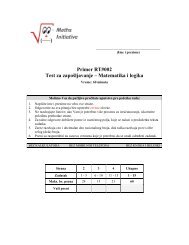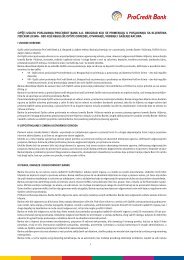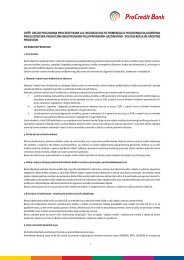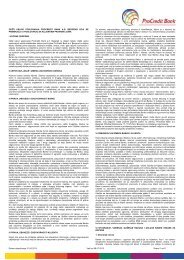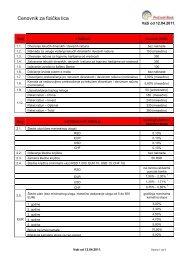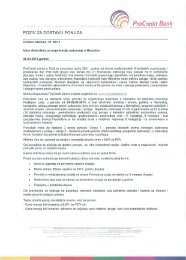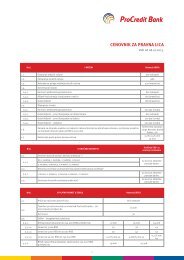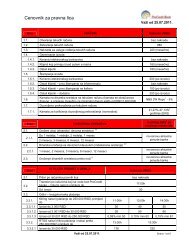Annual Report 2010 - ProCredit Bank
Annual Report 2010 - ProCredit Bank
Annual Report 2010 - ProCredit Bank
- No tags were found...
You also want an ePaper? Increase the reach of your titles
YUMPU automatically turns print PDFs into web optimized ePapers that Google loves.
Financial Statements 61<br />
Individual provisioning assessment (impairment)<br />
Individual provisioning is calculated for clients whose total debt<br />
amount to the <strong>Bank</strong> exceeds EUR 30,000 (31 December <strong>2010</strong>: 1<br />
EUR = 105.4982 RSD) at the moment of classification (incl. client<br />
and all parties of related persons), and whose arrears exceed 30<br />
days at the end of the quarter (refers to both standard and reprogrammed<br />
loan). Condition satisfaction is evaluated one month prior<br />
to the end of the quarter, so that the <strong>Bank</strong>’s employees could be able<br />
to prepare the analysis by the deadlines envisaged for booking.<br />
In case of a client who has already had individual impairment calculated,<br />
fulfilment of the conditions and a new calculation are prepared<br />
on a yearly basis.<br />
Likewise, individual impairment can be calculated even in case<br />
when the client is in arrears less than 30 days (over EUR 30,000<br />
of total outstanding debt per group of related parties) if there are<br />
indicators of changes in the client’s business, i.e. if the client is facing<br />
certain problems in business and if the indicators show that the<br />
loan will exceed 30-day arrears. When monitoring the borrower’s<br />
financial position, whereby the frequency of monitoring is determined<br />
by the credit committee in accordance with the <strong>Bank</strong>’s policies,<br />
the credit committee assesses the credit risk pursuant to the<br />
criteria defined by the <strong>Bank</strong>’s different rules and regulations.<br />
The frequency of monitoring is determined by the credit committee<br />
pursuant to credit rules, and it is no less than once per year for<br />
credit clients of the <strong>Bank</strong>.<br />
When monitoring any one borrower, all factors which may have<br />
impact on aggravation of a client’s eligibility, or exacerbation of<br />
the pledge quality are taken into account, which may lead to some<br />
problems in claim collection, those factors being:<br />
• Information about the borrower’s financial problems or potential<br />
aggravation of the financial situation, from borrowers’ financial<br />
reports monitoring<br />
• Possibility of business cessation on account of financial problems,<br />
owner’s death or illness, changes in management structure,<br />
changes in buyer or supplier structure, changes in competition<br />
that may have a considerable adverse effect on the<br />
client’s business<br />
• Decrease in pledge value or liquidity<br />
• Historical trend of loan instalment payments, implying it is<br />
not likely that the total loan amount will be returned by the<br />
borrower<br />
• Other factors, such as general economic conditions, region<br />
risk, industry risk, regulatory risk, dependence on buyers and<br />
suppliers, and the like.<br />
The Credit Analysis Department, in cooperation with the responsible<br />
Loan Officer, is in charge of preparation of the Impairment analysis<br />
for such a loan, on the basis of which the weight for individual<br />
provisioning is determined, taking also into consideration collection<br />
through pledge, and it gives proposals to appropriate credit<br />
committee level defined by credit rules, which makes the decision<br />
on individual provisioning for the respective client.<br />
Basis<br />
In case of individual impairments, the basis represents total<br />
amount of balance sheet receivables (due and undue principal, due<br />
interests), without deduction for deposit amount.<br />
Analysis of discounted cash flows (impairment analysis) – defining<br />
individual impairment weights<br />
Individual impairment of the book value of claim is determined on the<br />
basis of net present value of future inflows.<br />
Impairment analysis is performed at the level of the group of related<br />
parties for all balance sheet receivables of the bank from that borrower.<br />
Impairment analysis should be performed once per year for each<br />
client for whom the decision to have provisions with individual weight<br />
has been reached. If material changes occur during the quarter with<br />
the respect to the moment when individual weight has previously<br />
been determined, it is necessary to do a new analysis and determine<br />
a new weight. Risk weight used in this case in the event of calculation<br />
of provisioning presents potential loss for the bank in percentages.<br />
Impairment analysis is prepared taking into account both qualitative<br />
and quantitative criteria:<br />
• Client’s (group of related parties) total debt with respect to all<br />
credit (balance sheet) products in the bank, including bill of exchange<br />
protests, but excluding potential liabilities (documentary<br />
products) or <strong>ProCredit</strong> Leasing’s placements.<br />
• Claimed amount monitored in the course of the analysis are total<br />
due liabilities of the group of related parties (principal, due<br />
interest and due booked penalty interest).<br />
• Expected problems with loan collection, and problems client is<br />
facing.<br />
• Data on the pledge type and value, as well as pledge activation<br />
possibility.<br />
• Expected loan amount collection through borrower’s payments<br />
or through enforced collection from loan collateral activation<br />
in the next 3 years, and costs of activation.<br />
It is executed at the annual level by monitoring cash flows (operating<br />
cash flows that can be the source of loan repayment, sale of<br />
property and sale of collateral items). By discounting the said cash<br />
flows we obtain present value of future cash flows, and further potential<br />
loss in percentages (compared to present value of receivables),<br />
which is used as the provisioning weight.<br />
For the purpose of determining weight for individual claim provisioning<br />
from a particular borrower, it is necessary to:<br />
• Prepare cash flow projection that will include data on loan instalment<br />
maturity, as well as data about the expected loan collection<br />
through borrower’s payments and collection from sale<br />
of collateral items<br />
• Future cash flows of the expected collection are discounted by<br />
the weighted effective interest rate of the borrower’s total loans<br />
• The projected loss is calculated, on the date of impairment<br />
analysis, as a difference between receivables from borrower<br />
and present value of the projected collection arising from<br />
those receivables<br />
The weight for individual provisioning of the borrower’s total<br />
claims is calculated as a percentage of the projected Special rules<br />
for loan classification during loan repayment period<br />
The following cases require reclassification:<br />
1. Irrespective of the number of days in arrears, an individual loan<br />
will promptly be reclassified in class V pursuant to the credit<br />
committee decision if the loan agreement has been terminated<br />
(“Terminated“ status).<br />
2. Portfolio management committee (a body founded in accordance<br />
with <strong>ProCredit</strong> <strong>Bank</strong>’s procedures) has the right to pass<br />
on a decision on change of loan risk class in its regular monthly<br />
meetings, and on the basis of the proposal from the credit committee,<br />
for an individual case with increase in credit risk exposure,<br />
request impairment analysis on the basis of which the<br />
client will be individually reserved.<br />
Write-off policy<br />
As a rule of thumb, <strong>ProCredit</strong> <strong>Bank</strong> writes off all loans in loan repayment<br />
arrears for more than 360 days with the outstanding debt of



